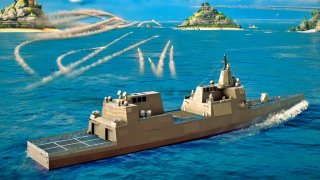The U.S. Navy's Paradigm-Shifting Navigation Plan
Lisa Franchetti is trying to break a paradigm. Admiral Franchetti is the newish chief of naval operations (CNO), or seniormost uniformed U.S. naval officer. What she says matters. Judging from her just-released “Navigation Plan,” or policy directive to the U.S. Navy, the CNO has come to believe that the Navy’s strategy, operational doctrine, and fleet design have fallen behind discomfiting new realities.
Likewise, CNO Franchetti embraces robotics in the Navigation Plan. Uncrewed vehicles are latter-day counterparts to the “flotilla”—swarms of torpedo boats and submarines—that harried fleets of battleships and cruisers a century-plus ago, denying them access to near-shore seas. Used in concert with missiles and minefields, they could hold the PLA at bay today.
Two, sea denial is an intensely joint venture amid Asia’s congested offshore geography. It conscripts all military services as sea services. U.S. Marine Corps operational concepts envision positioning small bodies of missile- and sensor-equipped troops on Pacific islands, chiefly along the first island chain, in order to hold Chinese shipping and aircraft at risk within the China seas while barring their exit into the Western Pacific or their return from the open ocean. The Army is experimenting with similar concepts, fielding long-range antiship munitions of its own. Air Force bombers and fighters now routinely practice delivering antiship ordnance.
So the U.S. Navy may be the “supported” arm of sea denial, spearheading the endeavor with help from other services. But maybe not. Joint commanders could relegate the fleet to a “supporting” role vis-à-vis ground and air forces depending on circumstances. It’s important to acculturate Navy folk not just to playing defense, but to the prospect of playing backup in a high-seas war.
And three, the new paradigm seeks to prolong any Pacific war. Waiting is the essence of defense; it’s about parrying enemy blows. Plus, U.S. and allied forces will need time to build up combat power, while the PLA will obstruct their movements at every opportunity. Protraction is the allies’ friend. Effective sea denial will confound PLA efforts to use the sea while providing an opportunity to weaken Chinese forces, even as the allies assemble sufficient forces to seize the offensive and win. Navy leaders should accept that they will not score a quick decisive victory over China on China’s home ground. U.S. commanders should do their utmost to stretch things out—foreclosing a speedy PLA triumph.
Defense, new technology, jointery, and time—there’s your new paradigm of naval warfare. Let the revolution proceed.
About the Author: Dr. James Holmes
Dr. James Holmes is J. C. Wylie Chair of Maritime Strategy at the Naval War College and a Distinguished Fellow at the Brute Krulak Center for Innovation & Future Warfare, Marine Corps University. The views voiced here are his alone.
Image Credit: Creative Commons.


